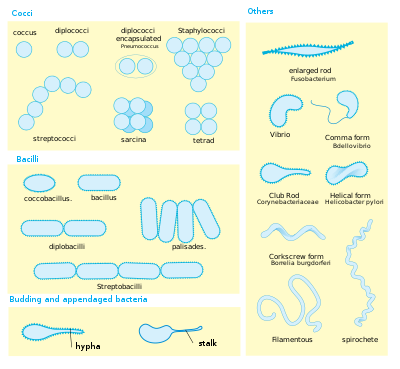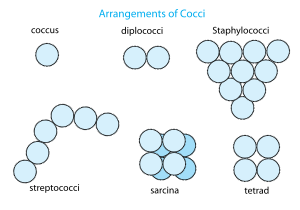Bacterial cellular morphologies
Bacterial cellular morphologies are the shapes that are characteristic of various types of bacteria and often key to their identification.Generally, the basic morphologies are spheres (coccus) and round-ended cylinders or rod shaped (bacillus).Cocci can grow in pairs, chains, or clusters, depending on their orientation and attachment during cell division.This genus, Neisseria, is divided into more than ten different species, but most of them are gram negative and coccoid.The gram-negative, coccoid species include: Neisseria cinerea, N. gonorrhoeae, N. polysaccharea, N. lactamica, N. meningitidis, N. mucosa, N. oralis and N. subflava.This genus, Moraxellaceae, comprises gram-negative coccobacilli bacteria: Moraxella lacunata, M. atlantae, M. boevrei, M. bovis, M. canis, M. caprae, M. caviae, M. cuniculi, M. equi, M. lincolnii, M. nonliquefaciens, M. osloensis, M. ovis, M. saccharolytica, and M. pluranimalium.The name Bacilli, capitalized but not italicized, can also refer to a less specific taxonomic group of bacteria that includes two orders, one of which contains the genus Bacillus.[25] The word coccobacillus reflects an intermediate shape between coccus (spherical) and bacillus (elongated).Haemophilus ducreyi, another medically important Gram-negative coccobacillus, is observed in sexually transmitted disease, chancroid, of Third World countries.Researchers discovered a protein that allows the bacterium Vibrio cholerae to morph into a corkscrew shape that likely helps it twist into — and then escape — the protective mucus that lines the inside of the gut.[34] A spirillum (plural spirilla) is a rigid spiral bacterium that is gram-negative and frequently has external amphitrichous or lophotrichous flagella.Owing to their morphological properties, spirochetes are difficult to Gram-stain but may be visualized using dark field microscopy or Warthin–Starry stain.






morphologiesbacterialight microscopearchaeaSpirochetesHaloquadratummicroorganismsphericalloanwordmodern or Neo-Latinstaphylococcalfood poisoningurinary tract infectionstoxic shock syndromegonorrheameningitispneumoniassinusitisgeneraDiplococciStreptococciStreptococcus pyogenesStaphylococciStaphylococcus aureusMicrococcusSarcinaSarcina ventriculigram-positiveStreptococcusS. pneumoniaegram-negativeNeisseriaMoraxella catarrhalisStreptococcus pneumoniaeEnterococcusencephalitis lethargicaNeisseria cinereaN. gonorrhoeaeN. polysacchareaN. lactamicaN. meningitidisN. mucosaN. subflavaMoraxellaMoraxella lacunataM. atlantaeM. boevreiM. bovisM. canisM. capraeM. caviaeM. cuniculiM. equiM. lincolniiM. nonliquefaciensM. osloensisM. saccharolyticaM. pluranimaliumarchaeonBacillusitalicizedBacilliGram stainingMacConkey agarE. colisalmonellaGram-positive bacteriaActinomycesClostridiumCorynebacteriumListeriaPropionibacteriumGram-negative bacteriaBacteroidesCitrobacterEnterobacterEscherichiaKlebsiellaPseudomonasProteusSerratiaShigellaVibrioYersiniaCoxiella burnetiiHaemophilus influenzaeGardnerella vaginalisChlamydia trachomatisAggregatibacter actinomycetemcomitansAcinetobacterBordetella pertussiswhooping coughYersinia pestisplagueCoxiella burnettiBrucellabrucellosisHaemophilus ducreyishapeshiftVibrio choleraeCampylobacter jejunispirillumamphitrichouslophotrichousCampylobactercampylobacteriosisHelicobacterHelicobacter pyloripeptic ulcersTreponema pallidumsyphilisspirocheteflagellaSpirochaetesdark field microscopyWarthin–Starry stainLeptospiraleptospirosisBorreliaBorrelia burgdorferiLyme diseaseTreponematreponematoseshelicallyBacterial morphological plasticityFerdinand Cohn